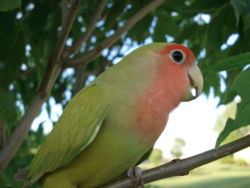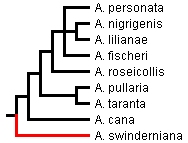| Lovebirds | ||||||||||||
|---|---|---|---|---|---|---|---|---|---|---|---|---|

A peach-faced Lovebird
|
||||||||||||
| Scientific classification | ||||||||||||
|
||||||||||||
| Nine - see text |
A lovebird (genus Agapornis, Greek for "lovebird") is a very social and affectionate parrot.
The name "lovebird" stems from these birds' affectionate nature. Lovebirds form very close bonds with their mates, usually lasting a lifetime. This is reflected by the lovebird's name in other languages: in German, "die Unzertrennlichen," and in French "les inséparables"- "inseparables." For this reason, many people feel strongly that lovebirds in captivity should be kept only in pairs. Others believe that lovebirds, like other parrots, are social animals who can bond with human companions when given a great deal of care and attention.
Lovebirds are about 13-17 cm in size, 40-60 grams in weight and characterized by a small, stocky build and a short, cute, blunt tail. This puts them among the smallest parrots in the world although their beak is rather large for their overall size. Many lovebirds are green, although color mutations can feature many different colors. Some lovebird species, like Fischer's, black cheeked, and the yellow collared lovebird, have a white ring around the eye. Lifespan is 10 to 15 years.
Contents |
Species and habits

Eight of the different species come from the mainland of Africa. The ninth species, Agapornis canus, originates from Madagascar. In the wild the different species are separated geographically. Lovebirds live in small flocks and eat mainly fruit, vegetables, some grasses and seed. Black-winged lovebirds also enjoy figs.
Only some of the lovebird species are sexually dimorphic. This includes the Abyssinian lovebird, the Madagascar lovebird, and the black-collared lovebird.
There are a total of 9 different species:
- Peach-faced Lovebird, Agapornis roseicollis
Masked Lovebird, Agapornis personata
Fischer's Lovebird, Agapornis fischeri
Nyasa Lovebird, Agapornis lilianae
Black-cheeked Lovebird, Agapornis nigrigeni
Madagascar Lovebird, Agapornis canus
Abyssinian Lovebird, Agapornis taranta
Red-faced Lovebird, Agapornis pullarius
Black-collared Lovebird, Agapornis swinderniana
Agapornis as pets
Like with any other pet, it is essential that one make sure the birds that one is about to buy were bred in captivity, and not wild caught. Besides conservational and ethical reasons, wild caught animals are more likely to get sick and to die. Lovebirds, especially when kept individually or brought up hand-fed, make very good pets. Lovebirds can be very interactive with humans, and when comfortable around humans, will willingly perch on human’s fingers and shoulders. Lovebirds rarely talk, but there is a chance they may learn to mimic human speech if taught to at a young age.

Housing
Lovebirds are very active and require an appropriately sized cage. They require lots of toys and things to chew on and play with. Lovebirds are extremely social birds, and there is debate on whether they should be kept individually. However, the consensus seems to be that they need social interaction, be it with conspecifics or human companion, for their emotional as well as physical well-being. Without this interaction, daily exercise, a roomy cage, and many toys to play with, they may resort to feather-plucking or other behavioral problems. They love to take baths almost every day and may sun themselves after bathing in order to dry
Food
Lovebirds require a variety of food, such as pellets, fruits, seeds, and vegetables. As a regular food, pellets are recommended, as the millet food generally sold in pet stores has too much fat in it and is not very balanced. Pellets specially made for birds provide a well-balanced diet. Fresh greens, such as spinach, are also extremely beneficial if not essential.

Potential problems
Lovebirds are very vocal birds, making loud, high-pitched noises that can be a nuisance. They make noise all day, but especially during the first morning hours.
As stated above, lovebirds are also very active, and love to chew things. When they are let out of their cage, it would be wise to watch them carefully, and protect any furniture, electrical wiring or anything else that they could possibly chew on.
Video
References
- ^ Eberhard, Jessica R. (1998): Evolution of nest-building behavior in Agapornis parrots. The Auk 115(2):455-464.




 216.73.216.91
216.73.216.91 User Stats:
User Stats:
 Today: 0
Today: 0 Yesterday: 0
Yesterday: 0 This Month: 0
This Month: 0 This Year: 0
This Year: 0 Total Users: 117
Total Users: 117 New Members:
New Members:
 216.73.xxx.xx
216.73.xxx.xx
 Server Time:
Server Time: